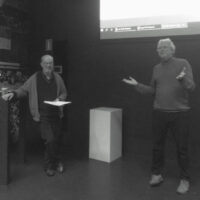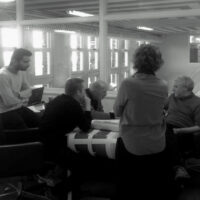Castex
Published as Timmermansoog column, website Architectenweb, 2018
 The French historian and architect Jean Castex co-authored the book Urban Forms (published as Formes urbaines in 1977 and in English in 2004). I met him before he gave a lecture on Palladio in Rotterdam. I thought I was paying Castex a compliment by confessing that although Urban Forms had made my life as a student difficult, it had simplified my design practice. With practical examples, the book demonstrated that the living environment cannot be tampered with.
The French historian and architect Jean Castex co-authored the book Urban Forms (published as Formes urbaines in 1977 and in English in 2004). I met him before he gave a lecture on Palladio in Rotterdam. I thought I was paying Castex a compliment by confessing that although Urban Forms had made my life as a student difficult, it had simplified my design practice. With practical examples, the book demonstrated that the living environment cannot be tampered with.
The difference between the front and the back of a house, for example, is stark. The Modernist house with lots of glass ignores the way in which residents take possession of it and want to regulate their relationship between their private domain and public space. Not for nothing is the French subtitle of Urban Forms ‘de l’îlot à la barre’ (From the Perimeter Block to the Slab). I do not read the book as an unprejudiced study of something like rational cities, but as a plea for urban form, based on the demise of the closed perimeter block that made way for problematic slab arrangements. For successive groups of architecture students it was a decisive handbook.
Castex did not accept my compliment. He immediately distanced himself from the book. Philippe Panerai was the main author. He himself wrote only the first chapter, on the Parisian city-block of the nineteenth century (a chapter that is indeed less didactic than the others). Castex went on to work on Renaissance architecture, Chicago’s urban development, and Frank Lloyd Wright. He never took an interest in a single field, style or era.

Anything goes is not Castex’s cup of tea. In Rotterdam, at the age of 77, he talked about Palladio’s architecture on the basis of the architect’s life story. The wealthy Gian Giorgio Trissino discovered the architect’s talent when he was still a stonecutter. He took him to Rome to study antiquity, gave him work, and introduced him to the right cultural circles. It should be noted that on the trip the young craftsman had to trudge behind his benefactor’s carriage.
More relevantly, Palladio became adept at coining incomplete success which, moreover, was not always attributable to himself. While he distinguished himself with the solidity of his buildings, he had to contend with awkward building plots and capricious clients. His handbooks – I quattro libri – present idealised, geometric and completed designs. These were ’buildings that he himself could not make’, as Castex observed. Humility coupled with grandiloquence, manipulated by purity and pragmatism – well, these are still indispensable characteristics of the starchitect.
To interpret Palladio’s work, Castex used the theory of type: typology. Fortunately, he did not mix up the concepts of type and typology. Type stands for immutable architectural arrangements. With some goodwill, it can be maintained that a type can be uniquely linked to a designer or client (think of McDonald’s restaurants). Typology is the study of those types, which orders and ranks them. As a contemplative discipline, typology is by definition impersonal. Through Palladio’s publications, his work became replicable. It became shareable – and influential to this day.
Castex did two more remarkable things. He emphasised the importance of architectural knowledge – after all, it was from this that Palladio’s career sprang. And Castex showed his own sketches. Here stood a practising architect who wanted to put his profession in comprehensible terms.

When asked about the development of his typology after Urban Forms, Castex said that typology not only orders and problematises, but also possesses creative capacity itself. It is precisely that strength that can be exploited. The understanding and interpretation of types precedes the design of the contemporary form, on the way to an architecture that is itself shareable. Between the idealisation of architecture and its total pragmatism lies a large field of knowledge that can be creatively exploited.
Gratitude to the Rotterdam Academy of Architecture, Like Bijlsma, text editing English translation: Charles Rattray